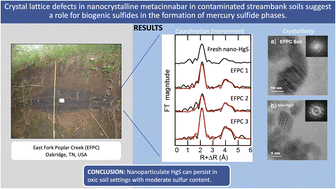Crystal lattice defects in nanocrystalline metacinnabar in contaminated streambank soils suggest a role for biogenic sulfides in the formation of mercury sulfide phases†‡
Abstract
At mercury (Hg)-contaminated sites, streambank erosion can act as a main mobilizer of Hg into nearby waterbodies. Once deposited into the waters, mercury from these soils can be transformed to MeHg by microorganisms. It is therefore important to understand the solid-phase speciation of Hg in streambanks as differences in Hg speciation will have implications for Hg transport and bioavailability. In this study, we characterized Hg solid phases in Hg-contaminated soils (100–1100 mg per kg Hg) collected from the incised bank of the East Fork Poplar Creek (EFPC) in Oak Ridge, TN (USA). The analysis of the soil samples by scanning electron microscopy-energy dispersive spectroscopy indicated numerous microenvironments where Hg and sulfur (S) are co-located. According to bulk soil analyses by extended X-ray absorption fine structure spectroscopy (EXAFS), the near-neighbor Hg molecular coordination in the soils closely resembled freshly precipitated Hg sulfide (metacinnabar, HgS); however, EXAFS fits indicated the Hg in the HgS structure was undercoordinated with respect to crystalline metacinnabar. This undercoordination of Hg–S observed by spectroscopy is consistent with transmission electron microspy images showing the presence of nanocrystallites with structural defects (twinning, stacking faults, dislocations) in individual HgS-bearing particles. Although the soils were collected from exposed parts of the stream bank (i.e., open to the atmosphere), the presence of reduced forms of S and sulfate-reducing microbes suggests that biogenic sulfides promote the formation of HgS nanoparticles in these soils. Altogether, these data demonstrate the predominance of nanoparticulate HgS with crystal lattice defects in the bank soils of an industrially impacted stream. Efforts to predict the mobilization and bioavailability of Hg associated with nano-HgS forms should consider the impact of nanocrystalline lattice defects on particle surface reactivity, including Hg dissolution rates and bioavailability on Hg fate and transformations.

- This article is part of the themed collections: Environmental Science: Processes & Impacts Recent HOT Articles, Geochemistry and Biogeochemistry of the Trace Elements


 Please wait while we load your content...
Please wait while we load your content...